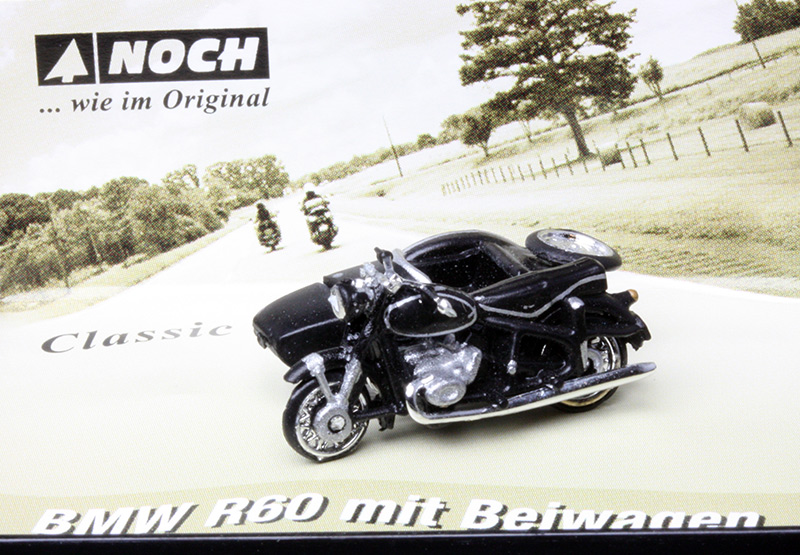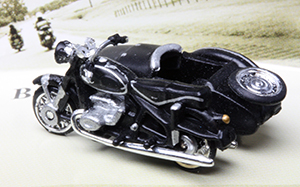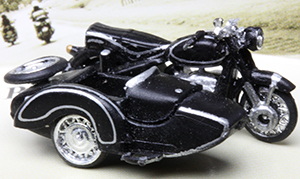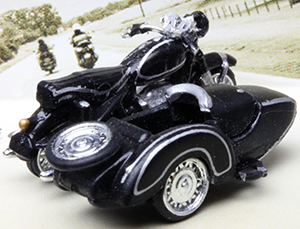Review - Noch 1/87 Scale BMW R60 Motorcycle With Sidecar
Please note: The opinions expressed in our reviews are the views of the reviewer and do not necessarily reflect the views and opinions of the 1/87 Vehicle Club. model critique by Bob Johnson
The BMW R60 was an opposed twin cylinder 600cc shaft drive motorcycle built from 1956 through 1969. Over the course of its production a total of 20,133 of these 30 horsepower bikes were reportedly built. These models, except for those with the "US" designation, were designed primarily as rugged motorcycles to pull sidecars (mounting points were built in) and had duplex tubular steel frames. Simultaneously manufactured were related models, including the 500 cc R50 (1955–1960, 26 hp), the R50/2 (1960–1969, 26 hp), the R50 S (1960–1962, 35 hp), the R50US (1968–1969, 26 hp), and the 600 cc sport-oriented R69 (1955–1960, 35 hp), R69S (1960–1969, 42 hp/31 kW), and R69US (1968–1969, 42 hp). In the United States, all these Earles-fork and US-fork (i.e., telescopic fork) models from 1955 to 1969 are often lumped together as "Slash-2" BMWs, even though that is technically incorrect. Not all of them, as seen above, have the "/2" designation. Though BMW first used oil-damped telescopic front forks in the 1930s, it chose to use Earles forks on these models. The triangular front Earles fork, named after its designer, Englishman Ernest Earles, precluded any front-end dive during heavy front braking, which is common with telescopic front forks. It also worked well in sidecar duty. Though heavy and ponderous in turning, the Earles fork gave the old bike a steady and reassuring ride. In 1968, BMW introduced telescopic forks on some of its slash-2 models, and they were continued into the 1969 model year. Modified, they became the front forks on the slash-5 models introduced for the 1970 model year. The photo of the red R60US to the right was taken at a BMW dealership in 1968 and shows a brand-new motorcycle waiting for its first buyer. Earles fork and telescopic fork models both were manufactured for these two years and were available to customers. During the 1960s, very few motorcycles were available with shaft final drive. BMW's were the most common. The driveshaft rode in an enclosed oil bath within the right swingarm, unlike BMW's previous models, and drove the rear wheel through an internally splined cup that meshes with a coupler crown gear keyed to the drive pinion. This meant that leaking seals could become a problem for the owners. Because the clutch was dry, there were seals at the rear of the crankshaft, at both ends of the transmission, at the rear of the driveshaft, and at the front and rear of the rear drive unit: lots of seals to develop leaks. The front brakes were double leading shoes, and the rear had a single leading shoe. By modern standards, they were not good brakes. Tires, front and rear, were interchangeable in 3.50 inch by 18 inch size. Motorcycles sold in America had high handlebars with a cross brace. Those sold elsewhere came with low, Euro handlebars. [Source: Wikipedia]
We would like to thank Michael Stephens of Walthers for the opportunity to review this model. We unconditionally recommend it as an addition to your collection whether on the shelf or on the layout for any time period from 1956 onward! A truly excellent model. |



 As we noted previously in our
As we noted previously in our  Without specific prototype dimensions for comparison we can only say the model scales extremely well to competing models. This view (left) shows more of the detail on the sidecar and spare tire mounting.
Without specific prototype dimensions for comparison we can only say the model scales extremely well to competing models. This view (left) shows more of the detail on the sidecar and spare tire mounting.